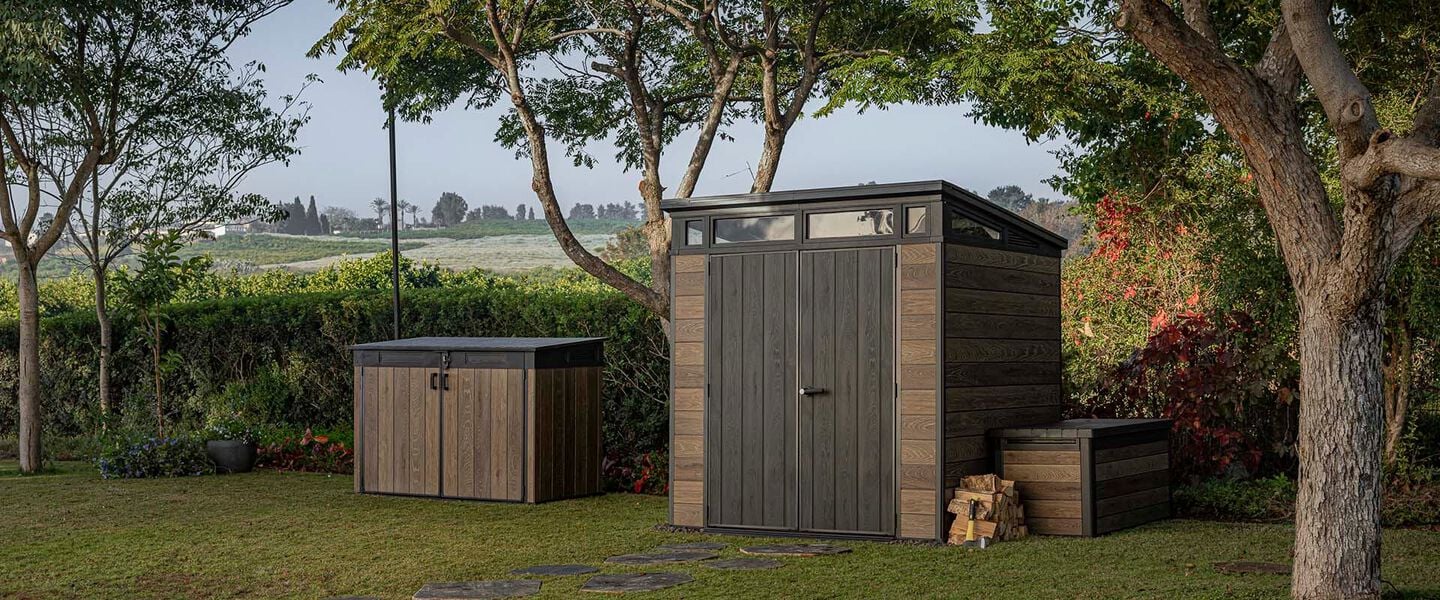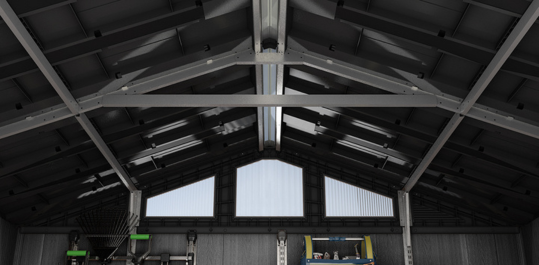
How To Insulate a Shed?
So you’re considering insulating your outdoor storage shed. Insulation is a great way to keep items more temperature-controlled since sheds are often exposed to the elements and don’t have heating and cooling systems like homes do. As you think about this project, it might seem a little overwhelming if you don’t know much about the types of insulation, the equipment you’ll need or even how to generally insulate your shed.
Don’t worry, though. We’ve put together a guide that will help you evaluate if you want to insulate and some general ideas behind the process before you decide to tackle insulating your shed head-on. Before we get started, it is important to keep in mind that the best place to get advice about insulating your shed is directly from your shed manufacturer if you didn’t build your storage shed yourself. Let’s get started!
Consider Your Shed Material Type
First things first, the type of shed you’re insulating matters. The most popular types are wood, metal and resin storage sheds. If you haven’t bought your shed yet, it’s worth carefully considering the type of things you need from a shed and how you want to insulate it before purchasing. You can read our guide if you want to hear more about the pros and cons of each shed type. Also, not every insulating type will work for every type of shed. So, keep this in mind as you are making plans!
What Is R-value When It Comes to Insulation?
When you’re shopping for insulation and doing research, you’re going to keep hearing about R-values. What is R-value, though, and why is it important when it comes to insulation?
Energystar.gov says, “R-Value is a measure of insulation’s ability to resist heat traveling through it. The higher the R-Value the better the thermal performance of the insulation.” They also have several useful charts and tables that can help you make better choices about insulation when it comes to your climate and the zone. Basically, it helps you know how well the insulation will work. So, pay attention to that as you shop for insulation.
What Are the Pros and Cons of Popular Types of Insulation?
Okay, so what are the different types of insulation? There are several different types of insulation, and if you're new to insulating sheds, it’s important to understand all of your options before getting started–the good, the bad and the ugly:
- Fiberglass Insulation: This is a super popular insulation type. It usually has a paper backing and a fiberglass front. It almost looks like cotton candy because it often comes in bright colors. However, it must always be handled with gloves because it can leave fiberglass in your skin when touched with bare hands.
- Pros: Simple installation and cheaper than some of the other options.
- Cons: Needs to be handled with gloves and possibly face protection.
- Cellulose Insulation: This insulation is often more eco-friendly because it’s made from recycled materials like paper. It almost looks like mashed-up linens.
- Pros: One of the oldest types of insulation that comes in blown-in or loose-fill forms. Offers good filling.
- Cons: It can’t get wet, it is heavy and it can be messy.
- Spray Foam Insulation: It is exactly what it sounds like. It’s foam that you spray in sections around your shed. If you haven’t seen a video of what it looks like, it’s fun to watch the process since the foam expands after it has been sprayed.
- Pros: Really good at getting into nooks and crannies. Offers a tight seal, and its R-Value doesn’t go down. Mold and mildew really can’t grow on spray foam.
- Cons: It can be a higher cost than other insulation. It can also contract, and you need to know what you’re doing if you’re going to go with spray foam. It may look easy, but it requires finesse and experience.
- Foil Insulation: They’re also called reflective insulation. They are large foil sheets that you can put around the walls and roof of your shed. They’re usually used in very specific instances of insulating.
- Pros: It doesn’t degrade as much, it’s lightweight, it’s waterproof, it can be used as a vapor barrier and it keeps things warm.
- Cons: It does not keep things cold, is pricey and needs to be clean to be effective.
- Foam Board Insulation: Foam board insulation comes in big boards that remind us a little of foam boards we used for posters during the science fair.
- Pros: It can help create a vapor barrier that helps with moisture, it can stop air from leaking in and it can help make your space more soundproof.
- Cons: Tends to be pricey, hard to install and not resistant to fire.
While everyone has different ideas of what type of insulation is best, it really comes down to your shed material type, budget, expertise and needs for the insulation.
What Tools You’ll Need to Insulate the Shed
This really depends on the insulation you decide to use for your shed. Each process is really different and will require special tools. For example, for fiberglass insulation, you’ll need adhesion (like a staple gun) to adhere it to the surface of the shed. However, there are a few general items you’ll need to start any shed insulation project:
- Gloves
- Mask for your face
- Eye protection
- Cover for clothes
- Box cutter
Use this list as a starting point when pricing out and shopping for insulation tools. Once you’ve decided on your insulation type, you can add on to this list.
Where Can You Put Shed Insulation?

So, when you’re insulating a shed, you need to make sure you’re looking at the whole shed. Most people think about insulating the walls, and most tutorials show this process. However, have you considered the roof or ceiling? Hot air rises, so insulating a shed roof is also important. You’ll also need baffles for ceiling insulation projects. What about a shed floor? Yes, you can insulate your floor too. Just make sure to take this into account as you price out your project–it’s easy to overlook the floor.
How Do You Insulate Your Shed?
This is a great question. The truth is that it depends on your shed type as well as the type of insulation you want to use. For example, if you’re going to insulate a wooden shed with fiberglass insulation, you’ll most likely be using a staple gun to attach the material to your shed. On the other hand, if you’re insulating a plastic storage shed with foam insulation, you’ll need the foam and a sprayer. So, the processes can vary quite a bit.
Your best bet is to contact the manufacturer of your shed and ask them what they would recommend for insulation before starting the process. If they don’t have any advice for you, or you built the shed yourself, it’s a good idea to find a video tutorial from a trusted source. This way, you can see how insulating a shed is done, and you might be able to avoid mistakes since you can watch the whole process play out in front of you. Generally speaking, though, you need to do the following to prepare to insulate your shed:
- Research Insulation For Your Shed Type: As we mentioned, talking to the manufacturer of your shed is your best bet, but the next best thing is to research what type of insulation works best with your shed. You can then price it out and find the cheapest way to insulate a shed before you get started on the project.
- Take Your Shed's Measurements: We get it, going back and forth from the hardware store 2-6 times during a project almost feels inevitable, but you can take fewer trips by measuring before you shop. Make sure you take measurements of everything. You might already know the height and width of your shed. However, you need to know the length between studs, how much roof you’re insulating, etc. Having these measurements will help you be better prepared when buying insulation.
- Make Sure Your Shed Is Clean: Don’t leave anything stored inside your shed while you’re insulating. It’ll get in the way and could get damaged. You’ll also want to make sure your walls are clean from dust, pests, cobwebs, etc.
- Price Out the Project: There’s nothing worse than getting ready for a project to only find out that it’s too pricey, or doing it another way would’ve saved you money. So, do yourself a favor by pricing everything out and leaving some wiggle room in your budget for hiccups. While we all want to find the cheapest way to insulate a shed, don’t scrimp on the quality if the temperature control of your shed really matters to you.
- Make a Plan: Once you have all of the information in front of you, you can make a more informed decision about insulating your shed. As we talked about above, if you’re new to insulation, maybe invite a friend over who has some experience, and/or watch some video tutorials before getting started.
While insulating your shed can be a bit of a detailed process, it’s totally worth it if you need to keep items in your shed more temperature-controlled.
There you have it, insulating a shed can be a big project, but it doesn’t have to be intimidating. As long as you research the type of insulation and the process for installing it on your specific shed, it shouldn’t be too complicated.
If you’re in the market for a weather-resistant, low-maintenance and durable resin shed, we’re sure we have a storage solution that will work for you. Our storage sheds come in three different sizes and even have features like double doors, windows and skylights. Be sure to check out our wide selection of sheds on Keter.com.

We build in a sustainable manner.
We use innovative materials and leading technologies to build planet-friendly products that last a lifetime.















